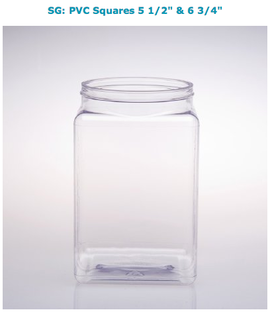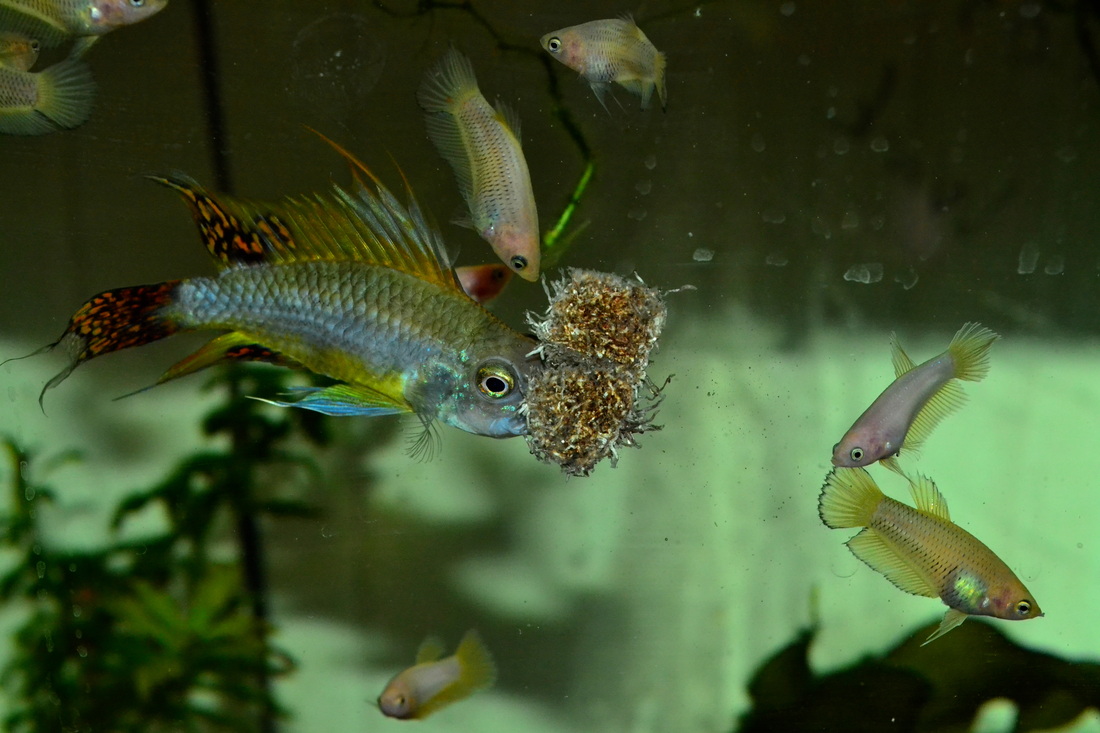Jarring
As your bettas approach around 2.5cm (1in) in length, you will start to notice secondary sex characteristics and increased aggression. The most aggressive are likely to be males. The anal fins will start to grow longer, and they will have small beards start to develop. Females become rounder in the belly area as they start to produce eggs, and a little white ovipositor will start to protrude. Their fins tend to remain shorter. The planted tanks and other non-betta fish ameliorate most of the aggression in the grow outs. I also try to feed in several different places in the tank so that the fry are spread out. I usually jar in stages, picking out the obvious males and bullies, and also the colors and forms that I am most excited about in that spawn.
In general, the most aggressive juveniles are young males. It is important to jar them before they start to damage one another’s fins. A potential show fish can be permanently ruined by early fin damage. However, the bodies of the bettas grow well in the grow out tank, so balancing when to jar can be tricky. I like to jar as late as possible so they develop robust and good-sized bodies. Bettas tend to slow their body growth and switch to developing their fins once jarred. I also jar in stages, picking out the most promising forms and colors, and also the bullies, first.
In general, the most aggressive juveniles are young males. It is important to jar them before they start to damage one another’s fins. A potential show fish can be permanently ruined by early fin damage. However, the bodies of the bettas grow well in the grow out tank, so balancing when to jar can be tricky. I like to jar as late as possible so they develop robust and good-sized bodies. Bettas tend to slow their body growth and switch to developing their fins once jarred. I also jar in stages, picking out the most promising forms and colors, and also the bullies, first.

The jars I use are from CCW plastics (http://www.ccwdist.com/). These jars are about a gallon in volume, and 4 of them fit neatly on each foot of wide Flexwatt heat tape (see right). They come in cases of 12 WITH lids, and I usually cut a *very* small hole in the top for feeding. I have also housed bettas in disposable ziplock food containers, cute little plastic squares from Daiso's, and glass jars. Really, anything goes (as long as it has a lid!)
|
|
I bought my Flexwatt Heat Tape from Big Apple Herp Supply (http://www.bigappleherp.com/Flex-Watt-Heat-Tape). I like the thick rubber tape that they sell to seal over the connectors, as opposed to the bulky plastic clips most other vendors have. I set my jars right on top of the tape, and hook a reptile thermostat into the circuit so I don't fry my fish! They stay at about 26C (80F). I only heat growing show prospects and breeding pairs. Adults and potential culls stay at room temperature (although they seem to do just as fine at RT. Check out how I wire Flex Watt heat tape for jars and tanks to the right! I finally got around to filming it lol. |
|
I only have 25-30 jars total, in order to keep things easy and fast. With each water change, I usually add about a 1/4 teaspoon of aquarium salt and a small piece of indian almond leaf (IAL). I also add enough IAL extract to turn the color a darkish tea color (explanative, I know). I find that my bettas seem to be more energetic when I add the IAL, and it really encourages the males to build bubblenests. I buy my IAL in bulk from the IBC store.
I'm pretty lazy about jars and normally change them only once a week, sometimes only once a week and a half. I have gone as long as 3 weeks, but after a while you run into problems like fin rot. For some reason, adding IAL seems to keep the jars cleaner...but don't quote me on that! :) If you want to be very good about jar cleaning,, I would change water a 1 gallon jar twice a week.
I have one jar that is especially dedicated to sick bettas, and it is used for no other purpose. I keep this jar far away from my other bettas, and the 1 gallon volume makes it very easy to calculate medication. I have had great success with medication with the few times I have had ick and velvet. I have cured once case of dropsy (my big blue gularis pet), but I was desperate and also very lucky. Once a betta gets dropsy, it should be humanely euthanized in ice water.
I'm pretty lazy about jars and normally change them only once a week, sometimes only once a week and a half. I have gone as long as 3 weeks, but after a while you run into problems like fin rot. For some reason, adding IAL seems to keep the jars cleaner...but don't quote me on that! :) If you want to be very good about jar cleaning,, I would change water a 1 gallon jar twice a week.
I have one jar that is especially dedicated to sick bettas, and it is used for no other purpose. I keep this jar far away from my other bettas, and the 1 gallon volume makes it very easy to calculate medication. I have had great success with medication with the few times I have had ick and velvet. I have cured once case of dropsy (my big blue gularis pet), but I was desperate and also very lucky. Once a betta gets dropsy, it should be humanely euthanized in ice water.

